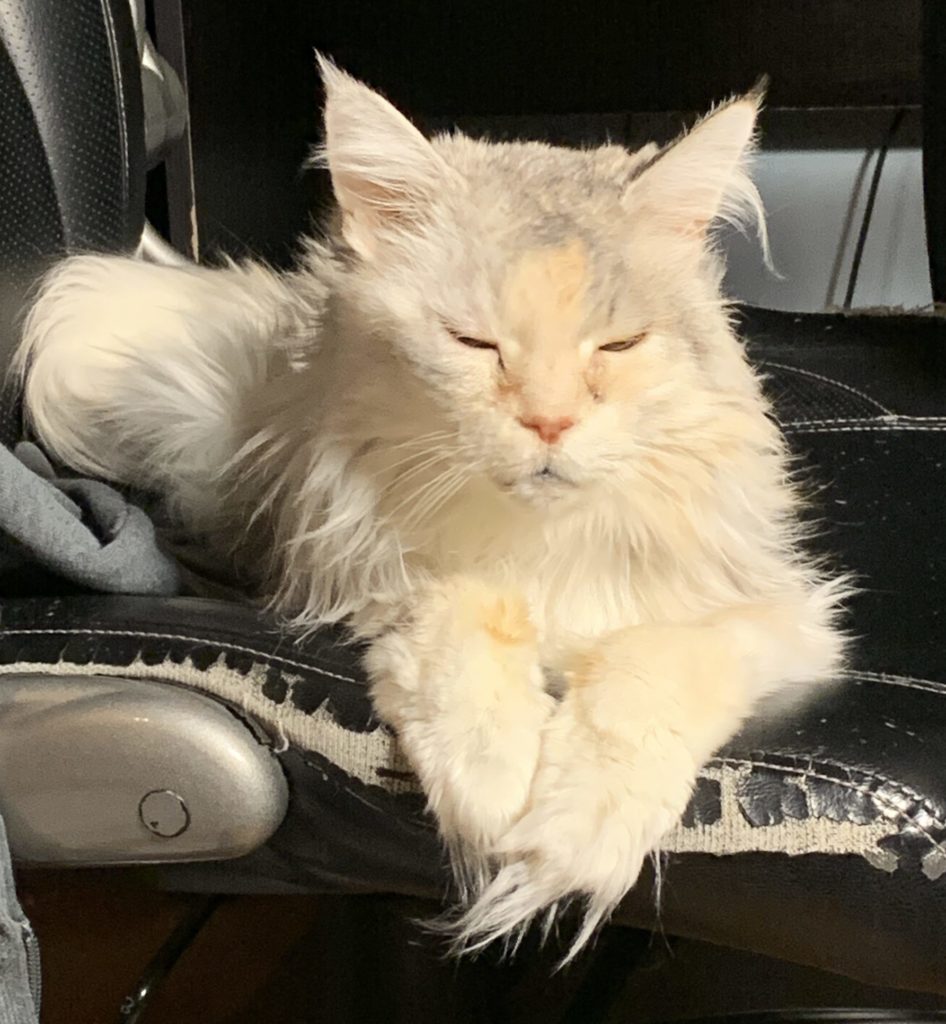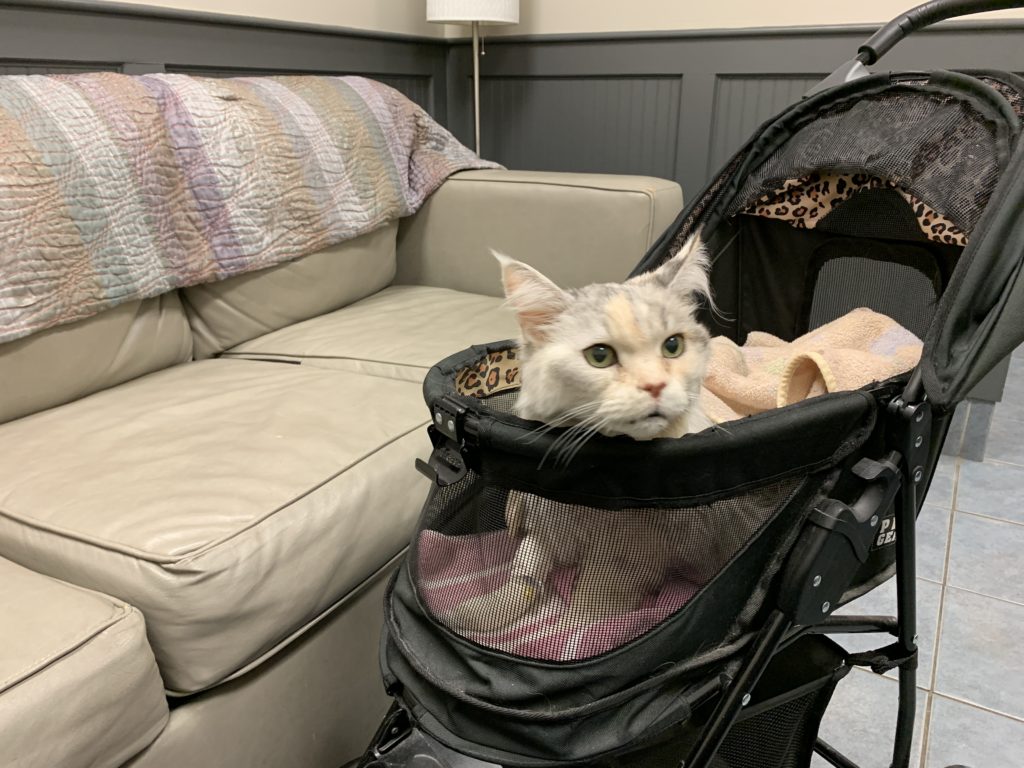(This started as part of a weekly update, but life, and the length of this, got away from me).

Our cat Brianna — affectionally known as Bri, Bitch Cat, or Pampered Princess — became sick at the end of January. While I was attending an oh-so-exciting landowners’ meeting, Matt heard her fall, and went to find that she was wildly uncoordinated, with her head swinging back and forth, and was having trouble walking. He brought her to the emergency vet, where I joined him.
While at the vet, she was having short, 30-second episodes of her eyes going back and forth (nystagmus), and it was quite frightening. Bri already had some chronic health issues — stomatitis, asthma, arthritis — and we were worried that whatever had been causing the mobility problems in her back legs wasn’t arthritis after all, but something more serious.
When we finally saw the doctor, she had nothing good to tell us — Bri had a raging ear infection, was very underweight (10lbs on a Maine coon!), and had the beginning signs of diabetes. None of this explained the symptoms, though, which the doctor thought were neurological in nature. She gave us a list of veterinary neurologists we could consult with, but explained that it would take an MRI to confirm anything, and that given Bri’s age (she’s 14) and physical condition, it was probably not worth doing, as anything they could find was almost certain to be untreatable, and that it was dangerous to put a cat in that condition under anesthesia for an MRI. She asked us to consider euthanasia.
(I asked at the time if the ear infection could be the cause of her symptoms, but the doctor didn’t seem to think it presented like ear infections she’d seen before).
So with no hope (but some antibiotics for the ear infection), we went home, thinking we were about to lose our girl.
But the story has a happy ending — or at least, a happier middle; we haven’t reached the end yet!
Next we asked our vet friend Becky who runs Autumn Care & Crossings to take a look at Bri’s record. If nothing else, we thought she could tell us if Bri is ready for palliative care and advise us if we wanted an at-home euthanasia. She came back and said, hey, why don’t you look into the diabetes thing more seriously? It could explain things like the “plantigrade stance” that the ER vet had noted on her chart. In particular she told us to test her fructosamine, which — similar to A1C in humans — measures blood sugar over time.
We did the diabetes testing at our normal vet, who also was pretty dire in her outlook, too (“you may do all this testing and still not get an answer”), but ran the blood tests anyway. The one positive suggestion she made, though, was that we at at least have a consult with a vet neurologist, as they could tell us better whether or not an MRI was worth pursuing.
So I made an appointment at Mass Veterinary Referral Hospital in Woburn, MA for Brianna, as they were the ones who could get us in the fastest: that Saturday. That Friday we found out that Bri’s diabetes tests were normal — so much for that as a solution — and then on Saturday we went to see Dr. Troxel at MVRH.
I liked Dr. Troxel — I was worried I wouldn’t, because I was warned that he could be brusque or business-like. I can definitely see that, as he’s not the warmest guy I’ve ever met. But he was deeply committed to this case right from the start, and that made me trust him. I also liked his responses to the questions I’d asked him: if he thought we were looking at end of life (“maybe, but I’m not ready to give up yet”) and what he would do if this were his cat (“Well, I gave my 19 year old cat an MRI… but I also have the employee discount”).
He also emphasized that not everything we could find on an MRI was a death sentence; there were some things that could be treated and give her “long-term quality of life.” I’ll basically do anything for my cats if it improves their quality of life, so that encouraged me to move ahead.
I’m SO glad we got that MRI, because it turned out: there’s probably nothing wrong with her brain! Even though her external ear infection had cleared up, the MRI revealed that she still has a raging inner ear infection, which Dr. Troxel told us would “absolutely” cause all the symptoms he was seeing. Still, was concerned due to two things — a bit of a contrast shadow he saw on the brain stem, which could either be an artifact, or a sign of infection in the brain, and a growth (that didn’t look cancerous) on her soft palate on the same side as her ear infection. He suspects that the growth may play a part in the ear infection; it’s near where the eustachian tube drains into the mouth, and it may be keeping her ears from draining properly. Given the stomatitis, especially in the back of her mouth, it’s not surprising that there’s an overgrowth of tissue back there.
After the MRI, while Bri was still under anesthesia, we gave the green light to do a spinal tap (to make sure there was no infection), and do a retroflex endoscopy (to see what the growth on her palate might be). That… didn’t so much happen. Brianna apparently stopped breathing on her own before they could start the procedures, and they had to resuscitate her and bring her out of anesthesia. (I was interested to learn they use naloxone for this — the same thing human medics use to reverse overdoses). I had about ten seconds of panic while Dr. Troxel was explaining this — he had to stop and say, “it’s all right, she’s fine now!” because I was afraid he was about to tell us she had died under anesthesia.
So further testing is off, at least for now, and Brianna had to stay in the hospital that weekend.

We learned some interesting things from the other tests they did: an abdominal ultrasound and an echocardiogram. The echo revealed that her heart murmur (which we already knew about; it varied between stage 2 to stage 4 depending on when and who was listening) was due to mitral valve disorder, which is unsurprising. Nothing immediately pressing there, but they want us to follow up with their vet cardiologist, Dr. Sosa, in 4-6 months. No signs of hypertrophy, though, which is good — hypertrophic cardiomyopathy is a common problem in Maine coons. (I seem to recall that all my cats have had a negative genetic test for HCM, though).
The abdominal ultrasound revealed some problems along her biliary tree, i.e. the liver, pancreas, and gall bladder. She had signs of chronic pancreatitis, benign liver cysts plus signs of cholangiohepatitis, and sludge in her gall bladder. All of this would explain her weight loss and lack of appetite! All of this is treatable with medication, though. They were concerned, given this, with the combination of conditions known as feline triaditis, and were doing blood tests for inflammatory bowel disease (cobalamine and folate), as that would complete the trifecta.
So in total, at MVRH we learned that Bri is still a very sick kitty, but that she can be treated! They put her on a more broad-spectrum antibiotic (clindamycin in addition to the Orbax they gave us at the e-vet) and reupped her Atopica (cyclosporine: an immunosuppressant which she takes for her stomatitis… may also help the liver if it’s an autoimmune condition there). When we took her home on Monday, they also gave us ursodiol from their compounding pharmacy, which is the same drugs humans take for similar conditions. We’ve also resumed the Flovent for her asthma, which had been on an as-needed basis before that. But if it will open up her airways, that’s to the good.
Her vestibular issues seemed a lot worse when we first brought her home, but after an hour in the car from Woburn, that’s unsurprising. And those sorts of issues are notorious for waxing and waning like that. She recovered quickly from that spell, though.
Now, she’s doing… astonishingly well, for a cat that we had nearly given up on. We got a baby scale to keep an eye on her weight (thanks, Buy Nothing group!), and her weight seems to have stabilized. She’s getting around easier, she definitely seems more alert, she’s been jumping into Matt’s lap and onto the chairs, and she can be left alone for short periods of time. She’s still confined to kitty jail (the computer room), though (Matt’s been sleeping on a futon on the floor with her). We’re less worried now about her falling than we are about her not getting her share of food at meal times, with two other cats in the house. So we’re probably going to keep her confined until she puts on more weight.
That was originally my whole post, but an update with even better news: we had a followup with Dr. Troxel and with Dr. Phillips (the internist) yesterday. Dr. Troxel did his usual examination and seemed happy with her progress — her walk is less ataxic and she definitely knows where her feet are. We’re going to keep her on the clindamycin for as long as she can tolerate — probably four more weeks. He says ideally they would do more imaging to make sure everything is clearing up, but it’s not necessary, and he preferred to go with the clinical signs.
Before we met with Dr. Phillips, we received news that Bri’s folate levels were low, which suggests IBD (and thus triaditis) after all. Basically, though, we’re already treating her for that with the ursodiol and the Atopica she was already taking for stomatitis. (This kitty has all the autoimmune disorders!) We should keep an eye out for any acute symptoms, however, there can be flareups that need to be treated with fluids and antibiotics.
Dr. Phillips also added a couple of drugs to Brianna’s routine: a transdermal appetite stimulant, to hopefully encourage her to put on more pounds, and a probiotic, to help with the side effects of the long-term antibiotics.
(I liked her a lot, too — all the vets I’ve met at MVRH are great! I wish Matt had given her more of a chance to talk, but he was very eager to share all the details of Bri’s daily routine, meds, behavior, etc).
Other than that, no followup appointments with either doctor, but we will need to do some followup bloodwork, and keep an eye out for any acute symptoms. Neither doctor mentioned trying the scope or the spinal tap again, and I’m hopeful that won’t be necessary.
So… that’s the emotional rollercoaster I’ve been on for the past month or so — or at least one of them. How are you?
Yikes! That is a rough set of things to deal with — I’m glad that a combo of good doctors and persistence seems to be leading to recovery, though!